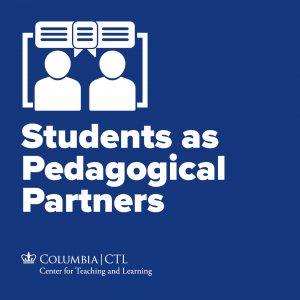Reflections on the Return to In-Person Learning in Fall 2021
In Fall 2021, we asked our student consultants to reflect on their experiences with the return to in-person learning, as part of the Students as Pedagogical Partners initiative. Below, they share what has been most helpful in supporting them through their return to Columbia classrooms.
To reflect on your return to in-person teaching, see the CTL’s resource Reflecting On Your Experiences with Remote Teaching: Making Meaning of Pandemic Teaching.
Transparency and communication: “[Transparency and communication] have been helpful for me in creating a balance between our celebration of the return to the classroom and acknowledgement of the aspects that shape our current teaching and learning environment.” — Yarin Reindorp, General Studies (Major: Neuroscience and Behavior)
Intentional use of technology: “I have found my professors’ intentional use of technology to be an integral support to my education both in and out of the classroom.” — Michelle Yao, Columbia College (Major: Biological Sciences)
Transparency and Communication
— Yarin Reindorp, General Studies (Major: Neuroscience and Behavior)
The return to the physical classroom has been energizing beyond expectation. I have been looking forward to returning to an in-person learning environment and have been pleasantly surprised by how quickly this transition brought back all the little things I had missed. By the end of the first day, I met old and new peers, made dinner plans with an old friend I had not seen in a while, and had a study group formed for one of my classes. I was reminded of the greater ease with which in-person interactions deepen both our interpersonal and learning experiences. It feels as though there is great momentum for engagement and connection, and it has been motivating to be a part of that once again.
With that being said, I try to remind myself that this is yet another transition we are going through and that this old-new routine of in-person learning and instruction requires adjustments for many of us. The pandemic and its challenges are still with us, in some old and new forms, many of which extend beyond the classroom. Family obligations, commuting, as well as getting used to masks in the classroom, restrictions, and looming uncertainty affect us students and instructors equally, and therefore I feel that acknowledging and addressing these aspects of our return helps keep me connected to my peers and instructors.
I especially appreciated instructors’ decisions to directly address the transition by offering ways to ease it. One of my instructors now offers both in-person and remote office hours, for example, which was a great advantage of online learning for me as it enhanced my ability to attend office hours despite other obligations outside of school, and has now made the transition more manageable. Another professor invited us to provide feedback on how the return to the classroom has been for us so far.
Actions like these reflect transparency in the way we communicate and adjust together. They have been helpful for me in creating a balance between our celebration of the return to the classroom and acknowledgement of the aspects that shape our current teaching and learning environment, and thus given me a sense of clarity and focus in my learning.
Intentional Use of Technology
— Michelle Yao, Columbia College (Major: Biological Sciences)
After being online for a year and transitioning back to in-person classes, I have found my professors’ intentional use of technology to be an integral support to my education both in and out of the classroom. It has made me feel assured in the quality of my learning regardless of extenuating circumstances that might make it difficult for me to attend class in person, allowed me to easily gain access to a professor’s course material through open access textbooks without financial burdens, and provided me with the opportunity to visualize and understand concepts in diverse ways beyond textbooks. Below are some specific examples from my classes where I feel that my professors’ choice in technology usage has made a significant impact on how I have approached learning this semester.
- The option to join class remotely if I am sick, with the encouragement to fully engage, allows me to continue learning without disruptions.
I have found it particularly helpful when my music humanities professor provides a remote option to attend class. When he shares his screen on Zoom for my classmates who are unable to join the physical classroom, while also encouraging them to participate as if they were in person, I am reassured that if I ever have an unforeseen circumstance, my education will not be compromised. For example, when some of my classmates were unable to attend class in person due to sickness, my professor not only opened Zoom for them to listen into the class, but he also took the time to acknowledge and encourage students on Zoom to participate in discussions by unmuting themselves and read their comments from the chat. By making the effort to give equal attention to students regardless of whether they are online or in person, my professor effectively makes us feel like we are contributing and participating members of the classroom community.
- Collaborative class activities allow me to build community with my peers both in in-person and remote modalities of synchronous learning.
My biochemistry professor creates the same type of flexibility with online and in-person instruction while fostering a community among students in the class. He structures his class around group collaboration, and whenever there is a discussion question, he places people on Zoom into breakout rooms for discussion in the same way that people in class are able to talk in their assigned groups. I appreciate it when my professor makes the effort to create space for students to meet and work with people they have never met before and build closer relationships, especially in a large lecture setting.Having the opportunity to meet and build relationships with new and familiar classmates in a large lecture setting both on Zoom and in person allows me to know that I’m not isolated when learning a difficult subject, and that I can collaborate with and ask my peers for help. When I feel that I belong in a community, particularly in a large class, my learning improves because I am not scared to ask for help from both the professor and classmates I know, and also because class time becomes an opportunity to catch up with friends who motivate me to strive to become a better learner.
- Accessing course materials and my professors in a flexible way — through online textbooks and in-person and online office hours — removes barriers and provides me with full support for my learning.
Professors can also take advantage of technology for in-person instruction by providing students with open source learning materials. For example, my Cell Biology professor is using a free online textbook by the National Institutes of Health to teach the subject, and it has been extremely helpful in lowering the cost barrier for students who are unable to purchase an actual textbook.Another way to make learning more accessible is to maintain online and in-person options for office hours. By provisioning optionality, many students have the ability to take charge of their own learning while balancing their responsibilities outside of the classroom.For example, when my art humanities and biotechnology professors announce in class that they are available to meet at other times outside of class via Zoom if we can’t make it to their in-person office hours, I know that I am still able to get the support that I need to learn the material and do well in class.At the same time, keeping regular office hours, in addition to providing Zoom office hours, is important to increase access to students. Whether it is in person or on zoom, continuing to offer pre-arranged office hours during the day to meet with students makes it easier for them to reach out, since scheduling an appointment outside of office hours may take several days and put more burden on both the professor and student to coordinate between their busy schedules.
- Using technology has allowed me to engage with course content in diverse ways beyond the textbook.
Certain technology softwares help enhance my learning experience. For example, in my dance class, I feel that I am really understanding the history and artistry behind a dance because my professor allocates 15 minutes at the end of class to discussing movement and comparative dances through youtube videos.Having my biochemistry recitation in virtual reality (VR) has also helped me better visualize molecules in a way that I have never been able to before. Using a VR headset and controllers, I am able to attend class from my dorm room and observe 3D molecular models in a virtual classroom space with my TA and classmates (all shown as virtual avatars). Within the virtual classroom space, I can turn the molecules using the controllers in all different angles, as well as enlarge certain active sites of the compound, which is not easily done in a physical recitation room that only has a whiteboard and markers.
Ask a Student!
Would you like to get a student perspective on how to make your classroom environment more supportive and engaging? The CTL undergraduate Students as Pedagogical Partners are available to share their thoughts (during the regular academic year). You are invited to submit your questions and our student consultants will respond with their insights and experiences.
Relevant Resources
Are you interested in learning more about effective teaching practices that students have referenced in their reflections, such as engaged lecturing and virtual office hours? Visit the following CTL resources for more strategies and tips:


